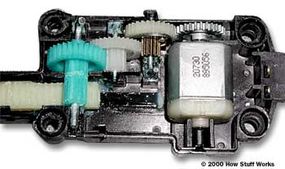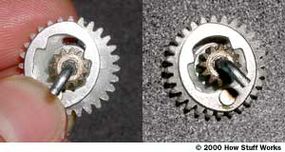Inside the Actuator
The power-door-lock actuator is a pretty straightforward device.

This system is quite simple. A small electric motor turns a series of spur gears that serve as a gear reduction. The last gear drives a rack-and-pinion gearset that is connected to the actuator rod. The rack converts the rotational motion of the motor into the linear motion needed to move the lock.
Advertisement
One interesting thing about this mechanism is that while the motor can turn the gears and move the latch, if you move the latch it will not turn the motor. This is accomplished by a neat centrifugal clutch that is connected to the gear and engaged by the motor.

When the motor spins the gear, the clutch swings out and locks the small metal gear to the larger plastic gear, allowing the motor to drive the door latch. If you move the door latch yourself, all of the gears will turn except for the plastic gear with the clutch on it.
